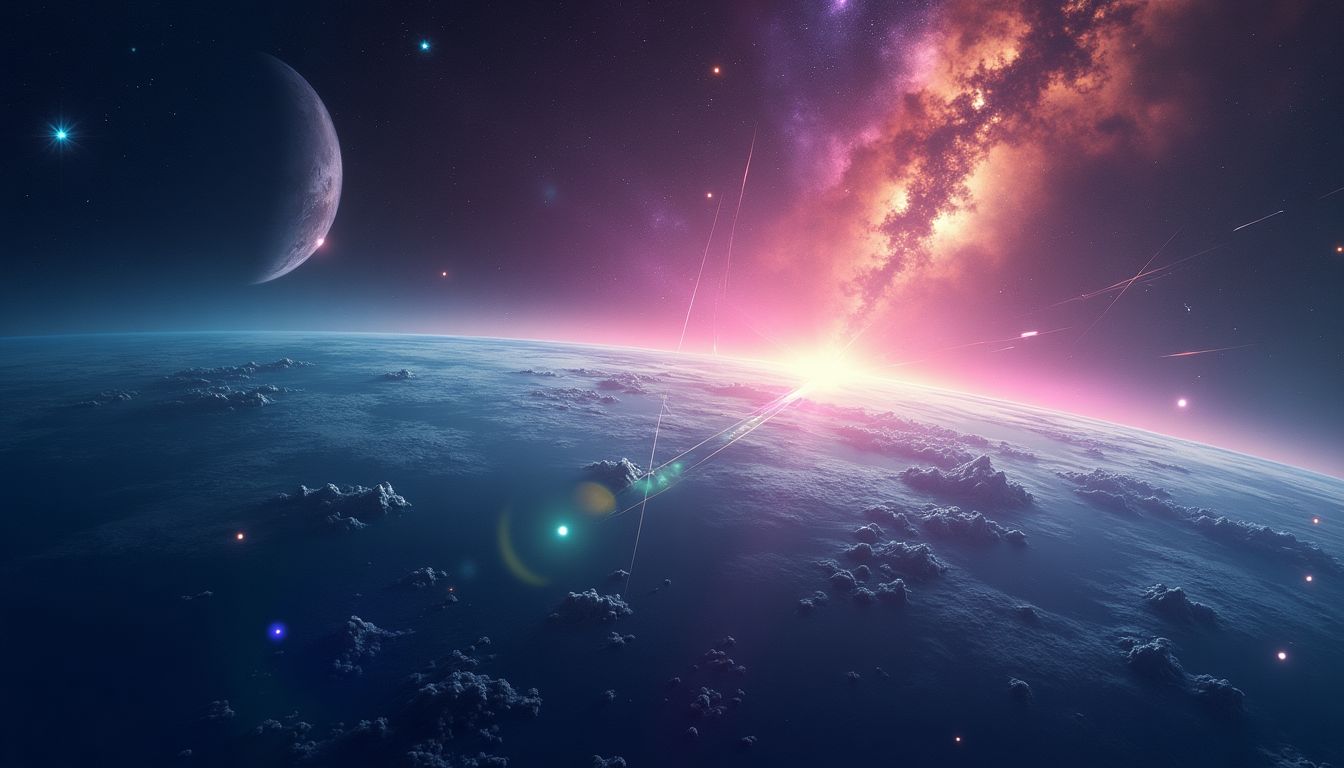Introduction: The Cosmic Quest
The greatest discovery of my generation is that a human being can alter his life by altering his attitude. – William James. In a way, this quote encapsulates our cosmic journey to explore alien life. Just as changing our perspective can reshape our existence, we are redefining our understanding of life beyond Earth with every new technological advance. Artificial Intelligence (AI), in all its glory, is standing at the forefront of this adventure, acting as our cosmic shovel in the deep space sandpit of data, digging up potential signs of life around distant stars.
What if our neighbors aren’t just two doors down but light-years away? Astonishing, isn’t it? The search for alien life not only stirs up our wildest imaginations but also challenges our assumptions about existence. We have embarked on a quest—one that seemingly started with the fanciful dreams of authors like Arthur C. Clarke, scientists like Carl Sagan, and researchers like Jill Tarter. They laid the groundwork for this cosmic curiosity, compelling us to seek answers in the vastness of the universe. So grab your tinfoil hat and prepare, because AI is dynamically enhancing our capabilities to probe the stars like never before.
1. The Significance of the Search for Alien Life
The search for extraterrestrial life raises fundamental questions about existence, evolution, and our future as a species.
1.1 The Philosophical Implications
Imagine peering through a cosmic window into the universe, only to realize that life is teeming beyond our planet. Now, that’s a mind-bending thought! The potential discovery of alien life would not just spark awe; it would send philosophers, theologians, and scientists scrambling for their pens and papers. It challenges our understanding of life, prompting us to reconsider everything we know about biology and the universe. What does it mean to be 'alive,' and how might intelligent life elsewhere affect our beliefs about ourselves? The implications could be staggeringly profound!
1.2 Technological Advancement through Exploration
Looking back, we notice that every ambitious leap into the great unknown has given rise to remarkable advancements. Humans are like cosmic toddlers, throwing spaghetti at the wall and hoping something sticks. The quest for extraterrestrial life has driven an extraordinary wave of technological innovations. From powerful telescopes that can peer into distant galaxies, like the James Webb Space Telescope, to communication technologies we use daily, the exploration of alien worlds propels our technological progress. Who would have thought chasing aliens might lead to better cell signal reception?
2. Understanding Biosignatures
Biosignatures are fascinating clues that tell us if life might be or once was on a planet. They can be anything from tiny molecules to large phenomena, acting like ancient postcards from potential life forms. Understanding these signatures is crucial for our cosmic quest. In this section, we'll explore what makes these biosignatures so intriguing.
2.1 Types of Biosignatures
Biosignatures come in various flavors, and it’s not just the "alien goo" variety you see in sci-fi movies. Here are some key types:
- Chemical Biosignatures: These include elements or compounds, like oxygen and methane, that are often associated with life. Imagine finding unusual gas mixtures wafting through the atmosphere of a distant planet. It's like the planet is sending us a signal saying, "Hey, look closer!"
- Physical Biosignatures: These are more on the extreme side. They can be structures or patterns, like stromatolites—layered structures created by microorganisms on Earth. So, if we find something resembling a funky rock formation on another planet, it might just be worth investigating.
- Atmospheric Biosignatures: Our atmosphere is a delicate mix, and detecting any unusual components could hint at life. Telescopes could analyze the air around planets, like a cosmic detective sniffing around for fingerprints.
2.2 The Role of Telescopes and Satellites
In our quest for extraterrestrial life, telescopes and satellites serve as the eyes in the sky—think of them as our cosmic smartphones! For instance, the James Webb Space Telescope (JWST) is designed to analyze distant exoplanets for biosignatures with incredible detail. Imagine having a powerful magnifying glass that can spot your lost keys from a mile away! It can collect data not just from the color of light but also the composition of atmospheres. This data allows scientists to create a list of potentially life-supporting planets.
3. AI in Data Analysis and Interpretation
Welcome to the nerdy heart of our search for alien life! The universe throws tons of information at us, from astronomical measurements to cosmic oddities. AI steps in like that friend who’s really good at handling spreadsheets—turning chaos into clarity. Let's dive into the exciting ways AI is making our job easier in understanding this massive data pool.
3.1 Machine Learning for Pattern Recognition
Machine learning is AI's way of spotting trends and similarities. It's like a cosmic Sherlock Holmes! By sifting through immense datasets, machine learning algorithms can spot patterns that could indicate biosignatures. This helps scientists connect the dots in ways they never could before. Remember those boring math problems from school? Well, they're a piece of cake for AI!
3.2 Neural Networks and Predictive Modeling
Neural networks take things up a notch. Think of them as virtual brainstorming sessions for predictions. By mimicking the way our brains work, these networks can create models of planetary atmospheres, predicting their habitability based on data from similar worlds. If Earth were a movie character, neural networks would be the sidekick, working tirelessly to plot out the next scene! This helps us assess which planets might actually support life.
4. The Search for Exoplanets
The hunt for exoplanets, or planets outside our solar system, has taken off like a rocket. With advancements in technology and telescopes, we are now uncovering new worlds that could potentially support life. This is a thrilling frontier, igniting the imagination of scientists and dreamers alike. Understanding where to look and how we find these distant planets is crucial in our quest for life beyond Earth.
4.1 Methods of Detection
There are several methods employed to detect exoplanets, each with its pros and cons. Here are some of the most common techniques:
- Transit Method: This technique involves observing the dimming of a star’s light when a planet passes in front of it. NASA's Kepler Space Telescope famously utilized this method to discover thousands of exoplanets.
- Radial Velocity Method: This method measures the star's "wobble" caused by the gravitational pull of an orbiting planet. Scientists analyze the light spectrum of stars to detect these tiny shifts.
- Direct Imaging: This involves taking pictures of exoplanets by blocking out the light from their star, revealing the planet’s light and atmospheric features.
- Gravitational Microlensing: This rare technique uses the gravity of a massive object to magnify the light from a distant star, allowing astronomers to see any planets around it.
By combining these methods, we are able to detect planets of various sizes and distances from their stars, leading to a fuller picture of the cosmos.
4.2 The Importance of Earth-like Exoplanets
Discovering Earth-like exoplanets in the habitable zone of their stars—where conditions could allow liquid water—is at the forefront of astrobiology. Here are a few reasons why these planets are prime targets:
- Potential for Life: These planets may host conditions suitable for life as we know it, increasing the possibility of finding microbial or even intelligent life.
- Similarities to Earth: Earth-like planets with similar sizes and compositions can provide a more relatable understanding of other life-supporting worlds.
- Studying Different Environments: Understanding the atmosphere and geology of these planets can offer insights into how different life forms might evolve and survive.
As discoveries of Earth-like exoplanets accumulate, so does our hope of encountering other forms of life in our universe.
5. Challenges and Limitations in the Search
Even with all the advancements we've made in technology and data analysis, the search for alien life comes with its fair share of challenges. These hurdles often make the pursuit of knowledge more complicated than it seems. Identifying life in the vast cosmic ocean requires overcoming some significant obstacles.
5.1 Data Overload
As telescopes and satellites diligently gather information, the volume of data generated is staggering. If not managed effectively, this data overload can drown our understanding. Key strategies to tackle this issue include:
- Using AI and Machine Learning: Implementing advanced algorithms to help in the organization and analysis of massive datasets.
- Data Filtering: Establishing protocols to rank data based on relevance, ensuring that the most promising signals are prioritized.
- Collaborative Platforms: Creating open-access platforms for scientists globally to share findings and insights, transforming individual data into collective knowledge.
5.2 False Positives and Interpretation Errors
In the world of space exploration, it's easy to mistakenly interpret signals as biosignatures. To combat this, researchers need to be diligent. Strategies include:
- Rigorous Verification: Implementing robust validation processes to confirm findings before public announcements.
- Multiple Confirmations: Utilizing various observation methods to cross-check data, ensuring accuracy in detection.
- Community Engagement: Encouraging scientists and citizen astronomers to review results collaboratively, reducing bias and enhancing insights.
Through these strategies, we can strive to mitigate the challenges faced in our pursuit of discovering life beyond Earth. Each obstacle presents an opportunity to innovate and refine our approach, igniting the possibilities for future discoveries.
6. AI Solutions: Enhancing the Search for Extraterrestrial Life
If I were an AI, I would implement a multi-faceted approach to enhance the search for extraterrestrial life. Here’s how I envision it unfolding:
6.1 Establish Clear Objectives
First and foremost, this effort would begin by establishing clear objectives, particularly focusing on identifying biosignatures on exoplanets. By pinpointing specific goals, the trajectory of research can be directed toward meaningful outcomes, ensuring that every initiative undertaken is purposeful.
6.2 Develop a Collaborative Data Platform
Next, a collaborative platform would be developed to aggregate data from various sources—telescopes, space probes, and historical records. This would not just be a database but a living ecosystem of information, enabling seamless access and interaction for scientists. Drawing inspiration from successful models like NASA's Astrobiology Institute, this initiative can harness collective knowledge.
6.3 Implement Advanced Natural Language Processing
Incorporating natural language processing (NLP) would empower the analysis of existing scientific literature. By synthesizing findings and insights from various scientific domains, AI can streamline the learning process and disseminate crucial information effectively, ensuring every key discovery is readily available.
Putting machine learning into action, I would focus on developing algorithms that classify potential biosignatures with high accuracy. These models would sift through massive astrophysical datasets, pinpointing anomalous patterns that could indicate life. The breakthroughs gained from OpenAI's research into GPT models and applications could inform the methodologies applied.
Additionally, creating dynamic predictive models would help simulate planetary conditions, assessing their habitability and likelihood of sustaining life. This would further enrich our understanding of exoplanets and the potential for life beyond Earth.
Actions Schedule/Roadmap
To guide our exploration over the next two years, the following roadmap delineates key milestones:
Day 1:
Launch an initial meeting with a diverse group of astrophysicists, AI experts, and representatives from organizations like ESA and JPL. Discuss the primary objectives of biosignature detection and analyze the intersection of AI and astrobiology.
Day 2:
Begin a comprehensive literature review of existing biosignature studies and AI applications. We could leverage resources from institutions like Caltech and MIT, tapping into their vast archives.
Day 3:
Form a highly specialized research team, inviting scientists from leading universities and industry experts to participate in this groundbreaking initiative.
Week 1:
Develop a framework for data aggregation, pinpointing key sources of astronomical data and current databases, such as the NASA Exoplanet Archive.
Week 2:
Begin the development of machine learning algorithms specifically designed for the auto-classification of biosignatures, employing frameworks such as TensorFlow or PyTorch.
Week 3:
Conduct an assessment of necessary computational resources. Collaborate with tech companies, like IBM and Microsoft, to leverage cloud computing capabilities.
Month 1:
Launch the initial phase of AI modeling, iteratively testing against known biosignature examples. This could involve datasets available through platforms like the NASA Exoplanet Missions.
Month 2:
Collaboration with experts in satellite observational data will be crucial to refine algorithms geared towards detecting astrobiological signals.
Month 3:
Release preliminary findings to the public, gathering feedback from the broad scientific community to enhance project methodologies.
Year 1:
Publish findings in respected, peer-reviewed journals, such as Nature or Science, while expanding outreach initiatives to involve citizen scientists in data analysis.
Year 1.5:
Integrate advanced AI systems for real-time analysis. Actively seek partnerships with private space companies like SpaceX to enrich observational technology.
Year 2:
Reassess and adjust project goals based on emergent technology and the discovery of potentially habitable exoplanets. Launch AI-driven outreach initiatives, educating the public about findings, and enhancing engagement in cosmic exploration.
Conclusion: The Cosmic Future Awaits
As we delve into the intriguing intersection of AI and the search for extraterrestrial life, we find ourselves standing on the brink of monumental discoveries. The intricate dance between advanced technology and the vast unknown has the potential not only to redefine our understanding of life beyond Earth but also to reinvigorate our curiosity and aspirations as a species. It presents an opportunity for collaboration across various sectors—academic, governmental, and private entities—to unite in a quest for knowledge that could illuminate the shadows of uncertainty. The advances in AI, particularly in its ability to process immense datasets, abound with promise, urging us to investigate the cosmos with renewed vigor and resolve.
Our quest, driven by inquiry and discovery, challenges us to look within as we explore the stars. The tools we develop today could unlock the mysteries of the universe and provide insights that redefine our existence. As we take these steps forward, let us remember that this exploration is about more than just seeking life elsewhere—it's about understanding the essence of life itself and our place in the cosmic tapestry.
FAQ
What is a biosignature?
A biosignature is any element, molecule, or even a physical feature that shows evidence of life on a planet. It can be as simple as a specific gas in the atmosphere, like oxygen or methane, or more complex indicators like certain patterns of minerals. Scientists use these clues to figure out if conditions could support life.
How does AI contribute to the search for alien life?
Artificial Intelligence (AI) plays a huge role in the search for extraterrestrial life by helping scientists process and analyze the enormous amounts of data collected from space. Here are some of the key ways AI contributes:
- Data Processing: AI can quickly sift through vast volumes of astronomical data to identify patterns.
- Biosignature Identification: It assists in pinpointing potential biosignatures by recognizing unusual data trends.
- Predictive Modeling: AI helps in creating models to predict whether a planet can support life based on its conditions.
What tools are used to find exoplanets?
Scientists use several tools to discover exoplanets, including:
- Space Telescopes: Instruments like the James Webb Space Telescope are specially designed to hunt for distant planets.
- Ground-Based Observatories: Large telescopes on Earth also play a crucial role in monitoring stars and spotting their planets.
- Spectrometers: These tools analyze the light from stars to detect the presence of exoplanets and study their atmospheres.
What are the main methods used to detect exoplanets?
There are two common methods used to find exoplanets:
| Method | Description |
|---|---|
| Transit Method | This involves watching a star and looking for small dips in brightness when a planet passes in front of it. |
| Radial Velocity Method | This technique detects a star's wobble caused by the gravity of an orbiting planet, indicating its presence. |
Are there any ethical considerations in the search for alien life?
Yes, there are several ethical questions that scientists consider while searching for alien life:
- Impact on Future Discoveries: What would it mean for humanity if we found intelligent alien life? How should we approach it?
- Environmental Concerns: Should we protect extraterrestrial environments as we would our own planet?
- Responsibility: What obligations do we have to beings we might encounter, and how should we treat them?
Where can I find more information about current research in astrobiology?
To learn more about ongoing research in astrobiology, you can check out:
- NASA's Astrobiology Institute - A treasure chest of resources on alien life research.
- ScienceDaily: Astrobiology News - Detailed articles and updates on the latest discoveries in the field.
- JSTOR: Astrobiology - Research papers and articles for more in-depth information.
Wait! There's more...check out our gripping short story that continues the journey: The Umbra
Disclaimer: This article may contain affiliate links. If you click on these links and make a purchase, we may receive a commission at no additional cost to you. Our recommendations and reviews are always independent and objective, aiming to provide you with the best information and resources.
Get Exclusive Stories, Photos, Art & Offers - Subscribe Today!





























Post Comment
You must be logged in to post a comment.